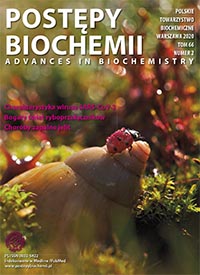Sirtuins in DNA repair
DOI:
https://doi.org/10.18388/pb.2020_319Abstract
DNA repair involves number of processes required for detection and repair of DNA damage. The ability to repair existing damage is crucial
for preservation of both physical integrity of the genome and fidelity of genetic information. Genetic insults may derive from either metabolic
reactions inside the cell or come from exogenous environment. Sirtuins belong to the class of histone deacetylases that catalyze the removal
of acetyl moieties from the lysine residues of both histone and nonhistone proteins. Furthermore, some sirtuins exhibit mono-ADP-ribosyltransferase
activity that regulates activity of various proteins. The first sirtuin was identified in yeast (Saccharomyces cerevisiae), however both
prokaryotic and eukaryotic homologs of sirtuins were later discovered. Seven mammalian homologs (SIRT1-SIRT7) exist. Sirtuins represent
an emerging group of enzymes that coordinate DNA repair in respect of cellular metabolic status and may have a prominent role in neoplastic
transformation, diabetes, ageing and age-related diseases such as neurodegeneration. The aim of this paper is to review recent research on the
role of sirtuins in DNA repair processes.
Downloads
Published
Issue
Section
License
Copyright (c) 2020 Advances in Biochemistry

This work is licensed under a Creative Commons Attribution 4.0 International License.
All journal contents are distributed under the Creative Commons Attribution-ShareAlike 4.0 International (CC BY-SA 4.0) license. Everybody may use the content following terms: Attribution — You must give appropriate credit, provide a link to the license, and indicate if changes were made, ShareAlike — If you remix, transform, or build upon the material, you must distribute your contributions under the same license as the original. There are no additional restrictions — You may not apply legal terms or technological measures that legally restrict others from doing anything the license permits.
Copyright for all published papers © stays with the authors.
Copyright for the journal: © Polish Biochemical Society.




